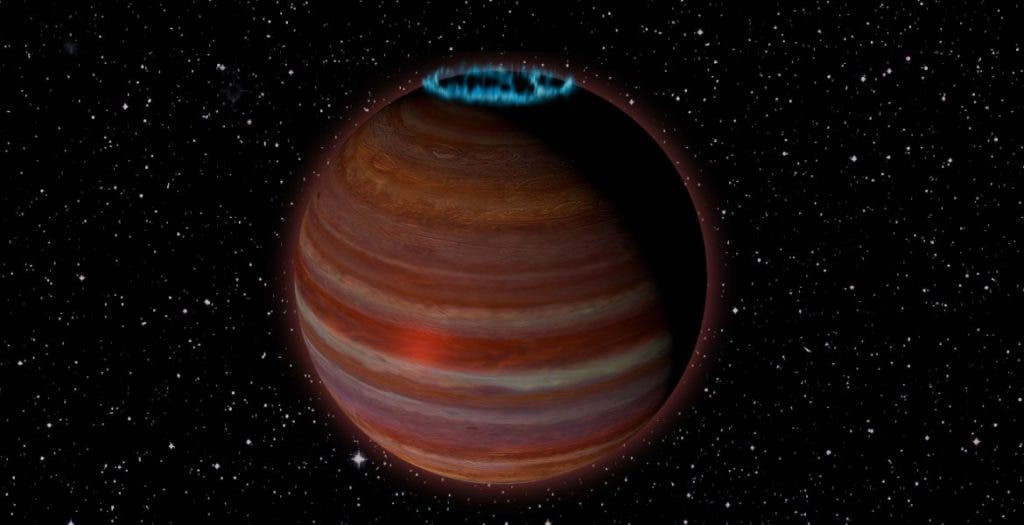Astronomers have discovered a rogue planet that’s almost too big to be considered a planet — and to top it off, the rogue object is a magnetic powerhouse.

The newly-discovered object resides 20 light-years from Earth and is some 12 times more massive than Jupiter, the largest planet in our solar system. It’s so big that it can barely be classified a planet — it’s almost a failed star.
“This object is right at the boundary between a planet and a brown dwarf, or ‘failed star,’ and is giving us some surprises that can potentially help us understand magnetic processes on both stars and planets,” said Melodie Kao, who led this study while a graduate student at Caltech, and is now a Hubble Postdoctoral Fellow at Arizona State University.
Brown dwarfs are substellar objects, with masses approximately 13 to 75–80 times that of Jupiter. Although they’re not planets, brown dwarfs are not massive enough to sustain nuclear fusion of ordinary hydrogen to helium — and therefore, are not technically stars either. However, it is thought that they fuse deuterium, and if their mass is sufficiently large, lithium.
Brown dwarfs were predicted to exist all the way in the 1960s, but the first one was only discovered in 1995, confirming the initial theories. However, not everything was successfully predicted: initially, brown dwarfs were thought to not emit radio waves, but in 2001, that was disproven.
This newly found planet, which borders a brown dwarf, has a magnetic field more than 200 times stronger than Jupiter’s. It was initially thought to be much larger and much older, but the new study has found that the object (called SIMP J01365663+0933473) is “only” 200 million years old. Additionally, new data from the Very Large Array (VLA), one of the most advanced radio telescope arrays on Earth, suggests that the object has a temperature of about 825 degrees Celsius or more than 1,500 degrees Fahrenheit. For comparison, the Sun has a surface temperature of 5,500 degrees Celsius or almost 10,000 degrees Fahrenheit. This fits with the object being between a planet and a brown dwarf and could provide valuable information about both groups.
But the abnormally high magnetic field makes it even more exciting. Kao and colleagues have found evidence of auroras on SIMP J01365663+0933473. The auroras on Earth are caused by our planet’s magnetic field interacting with the solar wind. However, brown dwarfs are typically solitary and don’t have a nearby star — therefore they don’t have any solar wind to interact with. This is also the case with SIMP, which is essentially a rogue planet. Scientists aren’t exactly sure how the auroras form in brown dwarfs, but they do have some theories. SIMP could shed some light on this phenomenon, and finally allow astronomers to understand the causes of this process.
“This particular object is exciting because studying its magnetic dynamo mechanisms can give us new insights on how the same type of mechanisms can operate in extrasolar planets — planets beyond our Solar System. We think these mechanisms can work not only in brown dwarfs, but also in both gas giant and terrestrial planets,” Kao said.
Such a strong magnetic field “presents huge challenges to our understanding of the dynamo mechanism that produces the magnetic fields in brown dwarfs and exoplanets and helps drive the auroras we see,” adds Gregg Hallinan, of Caltech, who also worked on the study. Hallinan also says that this process could provide a new way of detecting exoplanets — especially rogue planets, which are not orbiting a star.
“Detecting SIMP J01365663+0933473 with the VLA through its auroral radio emission also means that we may have a new way of detecting exoplanets, including the elusive rogue ones not orbiting a parent star,” Hallinan said.
Journal Reference: “The Strongest Magnetic Fields on the Coolest Brown Dwarfs,” by M. Kao et al. in the Astrophysical Journal Supplement Series.



